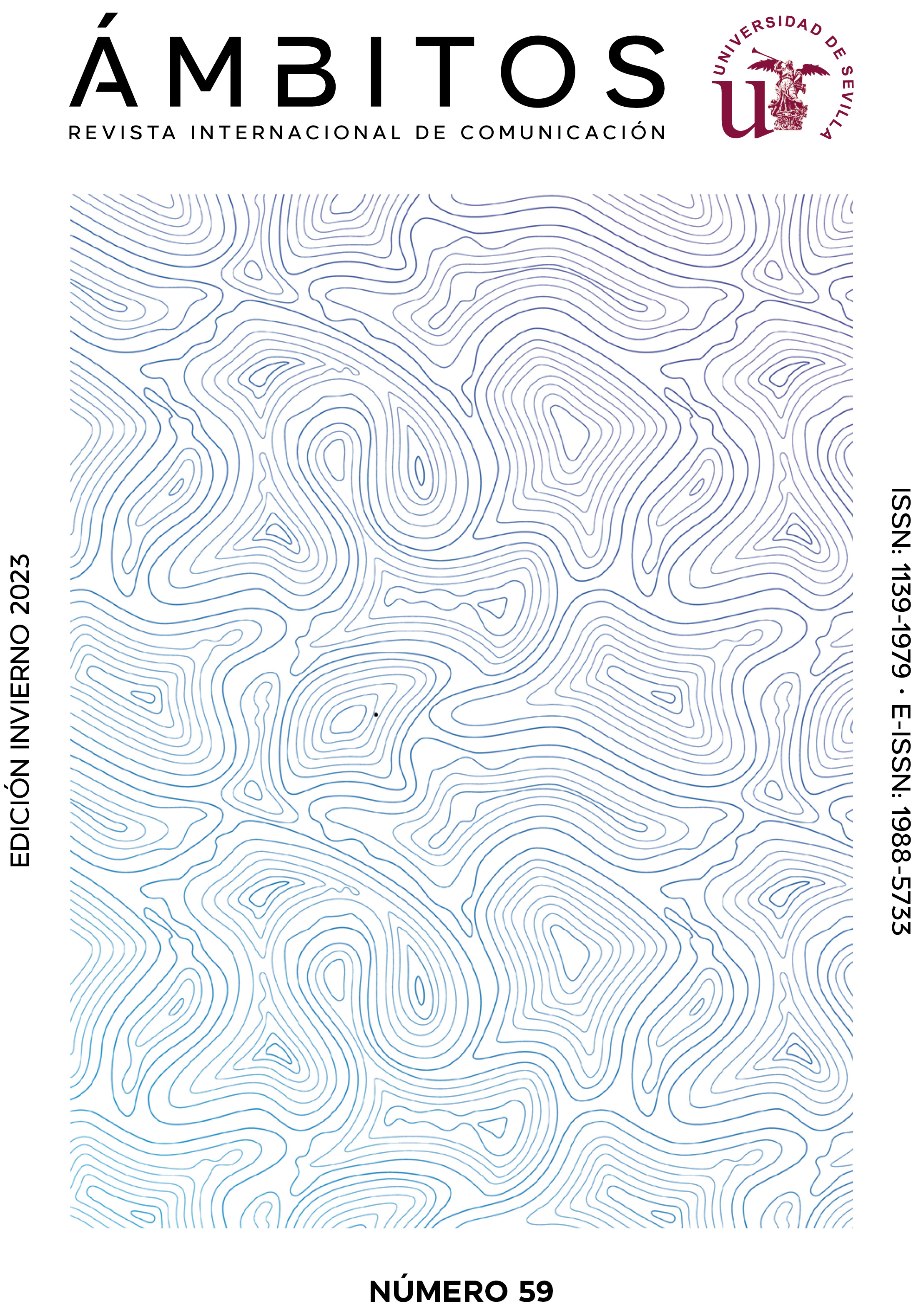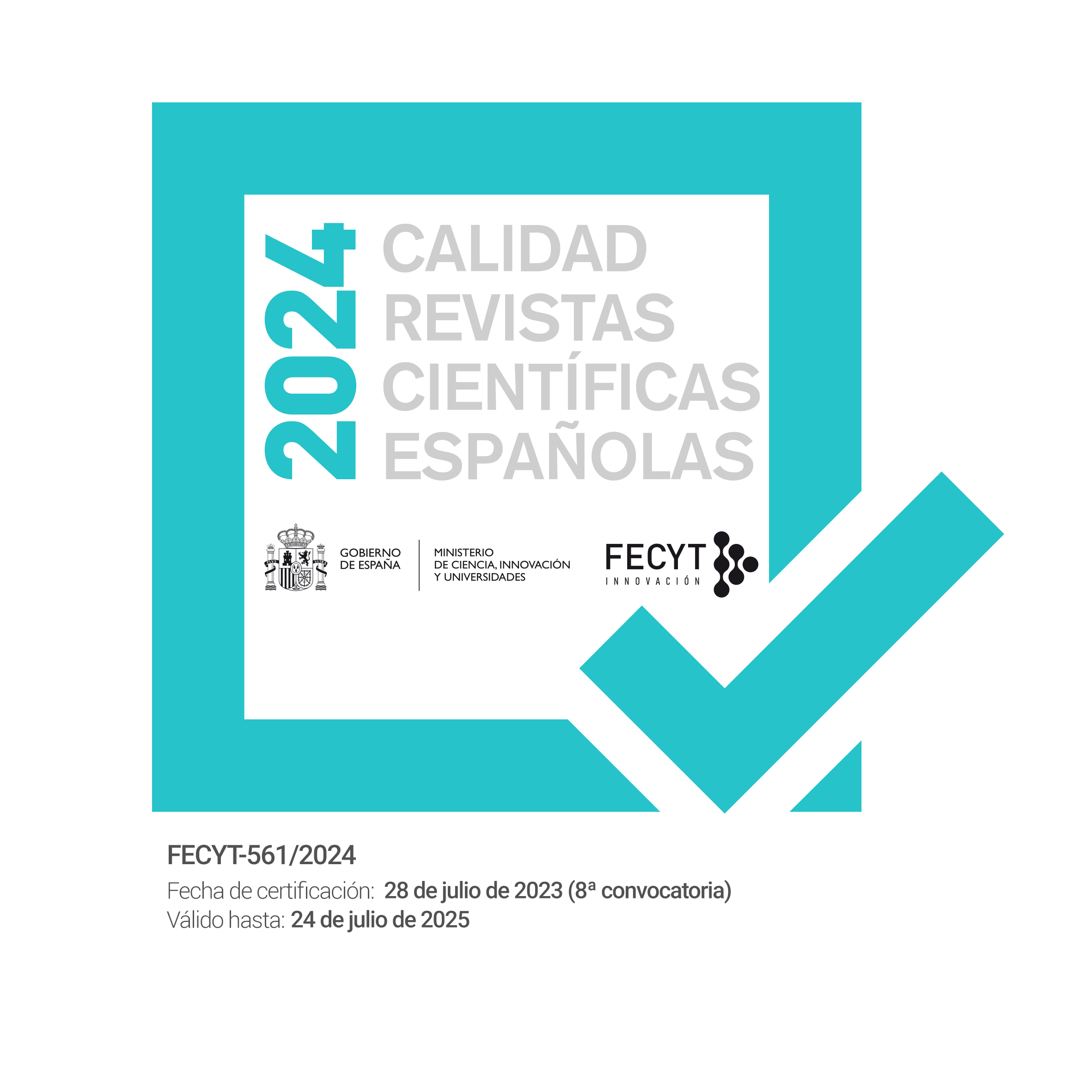The deconstruction of the Beautiful Figthing Girl through the Pygmalion archetype. Analysis of NieR Automata (2017) from a feminist poststructuralist perspective
Análise de NieR Automata (2017) a partir de uma perspectiva pós-estruturalista feminista.
DOI:
https://doi.org/10.12795/Ambitos.2023.i59.11Keywords:
Beautiful Fighting Girl, Otaku, NieR Automata, Video game, CyborgAbstract
Described by Saitō Tamaki in his essay Beautiful Fighting Girl (2011), this archetype corresponds to a series of patterns specific to Japanese fiction. From a Lacanian perspective, the author unravels the psyche of the otaku, tracing a structure where the barrier between fiction and reality are blurred through the magnetic field of sexuality and the hysterization of the subject towards fictional figures. Although, by definition, they are female characters who intervene in the course of their work and struggle to fulfill their will, these heroines perpetuate codes of fechitization stemming from Japanese heteropatriarchal culture. Thus, and by means of this paradox, outside the feminist post-structuralist currents of the West, characters oriented towards the desiring male gaze are created. However, Taro Yoko, in his video game NieR Automata (2017), exhibits characters that escape these canons, imposing a model closer to the socialist feminism of Donna Haraway's A Cyborg Manifesto (1984). Due the popularity of the Beautiful Fighting Girl in Japan and, by extension, in the West following recent neo-Japonisme waves this research is intended to serve those designers of videoludic narratives seeking feminist representations appropriate to contemporary postmodern discourses. To this purpose, an exhaustive analysis of the work's components and the symbolic contraposition of its elements will be developed.
Downloads
References
Aarseth, E. (1997). Cybertext: Perspectives on Ergodic Literature. Johns Hopkins University Press.
Aarseth, E. (1999). Aporia and epiphany in Doom and The Speaking Clock: The temporality of ergodic art. En M. Ryan (ed.), Cyberspace textuality: Computer technology and literary theory (pp. 31–41). Indiana University Press.
Aarseth. E. (2003, 28 – 29 de agosto). Playing Research: Methodological approaches to game analysis [ponencia] Conferencia de Artes Digitales y Cultura de Melbourne. Universidad de Bergen. Bergen, Noruega.
https://bit.ly/3DvG94w
Allouch, J. (2009). El sexo del amo. El Cuenco de Plata.
Álvarez, F. (2019). «Si haces esto, eres otaku»: reflexiones sobre las identidades constituidas a partir de objetos de la cultura de masas japonesa. Intersecciones en Comunicación, 13 (1), 235-256. http://bit.ly/3T42JH8
Azuma, H. (1999). Yubinteki fuantachi. Asahi Shinbusha.
Azuma, I. (productor ejecutivo). (1992-1997). Sailor Moon [serie de television]. Toei Animation.
Bailly, L. (2012). Lacan: A Beginner’s Guide. Beginner’s Guides.
Beck, V. Boys, S. Rose, C. y Beck, E. (2012). Violence Against Women in Video Games: A Prequel or Sequel to Rape Myth Acceptance? Journal of Interpersonal Violence, 27(15), 3016-3031.
https://doi.org/10.1177/0886260512441078
Bellah, R. N. (2003) Imagining Japan: The Japanese Tradition and its Modern Interpretation. University of California Press.
Bing, Y. Lin, M. Nonaka, A. y Beom, K. (2006). Harmony, Hierarchy and Conservatism: A CrossCultural Comparison of Confucian Values in China, Korea, Japan, and Taiwan. Communication Research Reports. 22, 107-115.
https://doi.org/10.1080/00036810500130539
Burgos, D. (2021). The Queer Glow up of Hero-Sword Legacies in She-Ra, Korra, and Sailor Moon. Open Cultural Studies, 5(1).
https://doi.org/10.1515/culture-2020-0135
Butler, J. (2007). El género en disputa. Paidós.
Caldwell, K. (2016). Fake the dawn: Digital game mechanics and the construction of gender in fictional worlds. [Tesis de Máster, Massachusetts Institute of Technology]. http://bit.ly/3Nu6ODk
Cockerill, J. (2019). Pretty guardians of a queer time and place. Voiceworks, 116, 33-38.
https://search.informit.org/doi/10.3316/informit.670997632795627
De Pablo Rodríguez, A. (2014). La tragedia de la rosa y la espada. Elementos simbólicos de masculinización en la mujer fálica del Shonen Manga. Kokoro: Revista para la difusión de la cultura japonesa, 14, 14-22.
http://bit.ly/3U2EZ7B
Delamorclaz, C. (2018). LGBTI y feminismo en animación televisiva: una reinterpretación de Steven Universe y Sailor Moon. Con A De Animación, 8, 164-177.
https://doi.org/10.4995/caa.2018.9655
Fernández, B. (2016) Análisis comparado de la representación femenina en la historieta y la construcción de arquetipos no sexistas. [Tesis Doctoral, Universidad de Oviedo]. https://bit.ly/3h7Zrp9
Fernández, B. (2019). Los secretos de las Magical Girl. Héroes de Papel.
Flores, A. y Velasco, P (coords). (2020). Ideological Games. Videojuegos e ideología. Héroes de Papel.
Frasca, G. (1999). Ludology meets Narratology: Similitude and Differences between (Video) Games and Narrative. http://bit.ly/3h7l9JZ
Grossman, R. (1980). Women’s place in the integrated circuit. Radical America, 14 (1), 29-50.
https://bit.ly/3FGQZaC
Haraway, D. (1984). Manifiesto Cyborg. Kaótica libros.
Hewlett, D. (2015). Anime and Identity: The Reception of Sailor Moon by Adolescent American Fans. East Asian Studies Summer Fellows, 1. http://bit.ly/3h6MVWY
Ito, M. Okabe, D. y Tsuji, I. (2012). Fandom Unbound. Otaku Culture in a Connected World. Yale University Press.
Jaćević, M. (2017, 28 – 1 de noviembre). «This. Cannot. Continue.» – Ludoethical Tension in NieR: Automata [conferencia] The Philosophy of Computer Games Conference. Universidad de Jagiellonian. Kraków, Polonia https://bit.ly/3WuSIpm
Joanette, Q. (2009). The Heroine’s reclamation of the girlish and the portrayal of girl-power in Sailor Moon. [Tesis Doctoral, Lakead University]. Library and Archives Canada. https://bit.ly/3NK23G9
Juul, J. (2001). Games Telling Stories? A Brief Note on Games and Narratives. Game Studies 1 (1).
http://bit.ly/3T0W2FX
Kinder, M. (1991). Playing with power in movies, television and video games: From Muppet Babies to Teenage Mutant Ninja Turtles. University of California Press.
https://doi.org/10.1525/9780520912434
Klevjer, R. (2001). Computer Game Aesthetics and Media Studies. Documento presentado para la conferencia 15th Nordic Conference on Media and Communication Research de Reykjavik, Islandia.
https://bit.ly/3haw9pG
Lacan, J. (1966-1967, 16 de noviembre – 21 de junio). La logique du fantasme. [seminario]. Faculté de Droit, Universidad de París. París, Francia. https://bit.ly/3Nsc7Dv
Lacan, J. (2001). Seminario 1: Los Escritos Técnicos de Freud. Paidós.
Lacan, J. (2003). Seminario 8: La transferencia. Paidós.
Lacan, J. (2013). Escritos 1. Biblioteca Nueva.
Lacan. J. (1999). Seminario 11: Los Cuatro Conceptos Fundamentales del Psicoanálisis. Paidós.
Lamarre, T. 2009. The Anime Machine: A Media Theory of Animation. University of Minnesota Press.
Latour, B. (1984). Les microbes, guerre et paix, suivi des irréductions. Métailié.
Latour, B. (2007). Nunca fuimos modernos. Siglo XXI Argentina.
López, F. y García, J. (2011). Arquetipos iconográficos femeninos en el cómic y la animación japonesa para adolescentes masculinos. [Ponencia]. Universidad de Sevilla. http://bit.ly/3zHZ4YL
MacKinnon, C. (1982). Feminism, Marxism, method, and the state: an agenda for theory. Signs, 7 (3), 515-544. https://doi.org/10.1086/493898
Mineau-Murray, L. (2021). Agentivités des personnages féminins dans les jeux de rôle japonais: le cas de Tales of. [Tesis de Máster, Université de Montréal]. https://bit.ly/3DTbY8U
Murray, Janet H. (1997). Hamlet on the Holodeck: The Future of Narrative in Cy-berspace. The MIT Press.
Nasio, J. (1998). Hysteria from Freud to Lacan: The Splendid Child of Psychoanalysis. The Other Press.
Navarro-Remesal, V. (2015). ¿La vida empieza o acaba con el matrimonio?: Amor, diseño de ética y libertad dirigida en Catherine. adComunica. Revista Científica de Estrategias, Tendencias e Innovación en Comunicación, 9, 43-61.
https://doi.org/10.6035/2174-0992.2015.9.4
North, D. C. (1981). Structure and Change in Economic History. Norton.
Ōtsuka, E. (1992). Kaso genjitsu hihyo [Critique of virtual reality]. Shin’yosha.
Ōtsuka, E. (2010). Word and Variation: The Reproduction and Consumption of Narrative. En F. Lunning (ed.), Mechademia 5 Fanthropologies (pp. 99-117). University of Minnesota Press
Ow, J. (2000). The revenge of the yellowfaced cyborg: The rape of digital geishas and the colonization of cyber-coolies in 3D Realms’ Shadow Warrior. En B. Kolko, L. Nakamura & G. Rodman (eds.), Race in cyberspace (pp. 51-68). Routledge.
Prough, J. (2011) Straight from heart: gender, intimacy, and the cultural production of shōjo manga. University of Hawai’s Press.
Shamoon, D. (2012). Passionate friendship: the aesthetics of girl’s culture in Japan. University of Hawai’s Press. https://doi.org/10.21313/hawaii/9780824835422.001.0001
Solberg, R. (2021). Playing posthumanism? NieR: Automata and the inescapable human. Documento presentado para la conferencia Literary and Aesthethic Posthumanism de Bergen. https://bit.ly/3sSQH8W
Sugimoto, Y. (2010). An Introduction to Japanese Society. Cambridge University Press.
https://doi.org/10.1017/CBO9780511781223
Takahashi, M. (2008). Opening the Closed World of Shōjo Manga. En M.W. MacWilliams (ed.), Japanese Visual Culture Explorations in the World of Manga and Anime (pp. 114-136). M.E. Sharpe.
Tamaki, S. (2011). Beautiful Fighting Girl. University of Minnesota Press.
https://doi.org/10.5749/minnesota/9780816654505.001.0001
Taro, Y. (2017). NieR: Automata (Versión PlayStation 4) [Videojuego]. Square Enix.
Vaz, B. (2016). La convergencia ludo-narratológica en el diseño de videojuegos de rol: las mecánicas jugables de Dark Souls contra el diagrama de flujo de Mass Effect. Comunicología Cubana, 92, 1-28.
Vossen, E. (2020). There and Back Again Tolkien, Gamers, and the Remediation of Exclusion through Fantasy Media. Feminist Media Histories. 6(1), 37-65. https://doi.org/10.1525/fmh.2020.6.1.37
Zeigler, B. (2000). Theory of Modeling and Simulation. Academic Press.
Žižek, S. (2003). El espectro de la ideología. En S. Žižek (comp.), Ideología: un mapa en cuestión (pp. 7-42). Fondo de cultura económica.
Downloads
Published
How to Cite
Issue
Section
License
Copyright (c) 2023 Carlos Álvarez Barroso

This work is licensed under a Creative Commons Attribution-NonCommercial-ShareAlike 4.0 International License.
Ámbitos. Revista Internacional de Comunicación is an open access journal, which means that all content is freely available at no charge to the user or their institution. Users may read, download, copy, distribute, distribute, print, search or link to the full text of articles, or use them for any other lawful purpose, without seeking prior permission from the publisher or author. This definition of open access is in accordance with the Budapest Open Access Initiative (BOAI).

Unless otherwise noted, all content in the electronic edition is distributed under a "Creative Commons Attribution-NonCommercial-ShareAlike 4.0 International License". You can consult the informative version and legal text of the licence here. This should be expressly stated in this way where necessary.
In case of acceptance of the manuscript, the authors cede the rights of the work for its publication to Ámbitos. Revista Internacional de Comunicación under the Attribution-NonCommercial-ShareAlike 4.0 International license contract (CC BY-NC-SA 4.0). The authors retain copyright and third parties are authorised to copy, distribute and make use of the work, provided they comply with the terms and conditions set out in the licence
- Cite the authorship and the original source of publication (journal, publisher and URL of the work).
- Do not use them for commercial purposes.
- If you remix, transform or create from the material, you must release your contributions under the same license as the original.
More information can be found at https://creativecommons.org/licenses/by-nc-sa/4.0/deed.es


















